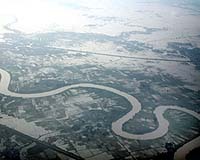Thousands of villages in India's Bihar state have been flooded for the last two weeks, but one hamlet has been under at least a foot of water for the last 12 years. Since 1995, Barabih residents have either got used to living with floods, or left. In fact about 75 percent of the population has fled, leaving behind 1,400 hardy souls.

|
| ©AFP
|
| Experts blame the plight of villages like Barabih on the haphazard construction of anti-flood embankments in Bihar, which has a reputation as one of India's most lawless, corrupt and impoverished states. In 1952, Bihar had 160 kilometres of embankments and the flood-prone area was 2.5 million hectares, said development expert Eklavya Prasad. "But by 2002 the state developed 3,430 kilometres of these structures and the flood-prone area extended up to 6.88 million hectares," Prasad told The Hindustan Times.
|
"
We have been campaigning for a almost decade for the authorities to drain this village of the stagnant water," said Navneet Thakur, the local leader of a cluster of five villages -- a panchayat -- which includes Barabih.
"But we have failed as even elected representatives ignore us," he told AFP.
The heaviest monsoon rains in some 30 years have made life unbearable, even if some locals admit they are used to surviving with water everywhere.
"But with these floods, now even the roads which we could earlier walk on have now vanished," said resident Ranjit Kumar.
The inhabitants blame the perma-flood on an embankment built by other village clusters nearby to ward off the annual inundations that plague Bihar.
"On top of that, a sugar mill in our vicinity discharges its effluent into Barabih which increases the level of the water in the village," Thakur said.
The air can be foul too, said village shopkeeper Ashok Singh.
"The discharge from the sugar factory sends black water into our village and the stench often is unbearable. And we don't have an inch of land to farm on," added Thakur.
Barabih, which lies in Sitamarhi district, 170 kilometres (105 miles) from the state capital Patna, does not boast any mains electricity either. Residents rely on truck batteries which they re-charge once a week in nearby towns.
The nearest medical facility is four kilometres away -- a good boat ride from the forlorn village.
But perhaps the over-riding complaint is that no one wants to marry a man from Barabih.
In a country where virtually all weddings are arranged and family life is sacrosanct, remaining unmarried is tragic.
"I have given up trying to get married," said 35-year-old Manoj Prasad.
"Our village is full of young men because no family in Bihar wants to send their daughters here to starve or push a boat for the rest of their lives like the rest of us," said Ashok Thakur, a 34-year-old bachelor.
Ranjit Kumar and unemployed graduate Sashank Kumar are among those who have failed to bring home a bride.
"The floods bringing in more water dooms our chances of raising a family," said Kumar.
Experts blame the plight of such villages on the haphazard construction of anti-flood embankments in Bihar, which has a reputation as one of India's most lawless, corrupt and impoverished states.In 1952, Bihar had 160 kilometres of embankments and the flood-prone area was 2.5 million hectares, said development expert Eklavya Prasad.
"But by 2002 the state developed 3,430 kilometres of these structures and the flood-prone area extended up to 6.88 million hectares," Prasad told The Hindustan Times.
"The reason behind this policy is easy to understand:
It helps perpetuate the well-oiled politician-technocrat-contractor nexus ... Cuts and kickbacks are the order of the day."
Nearly 14 million Biharis were affected by the floods when the state's six largest rivers burst their banks, officials said.
Meanwhile, the people of Barabih will carry on using their boats for the foreseeable future.
Reader Comments
to our Newsletter